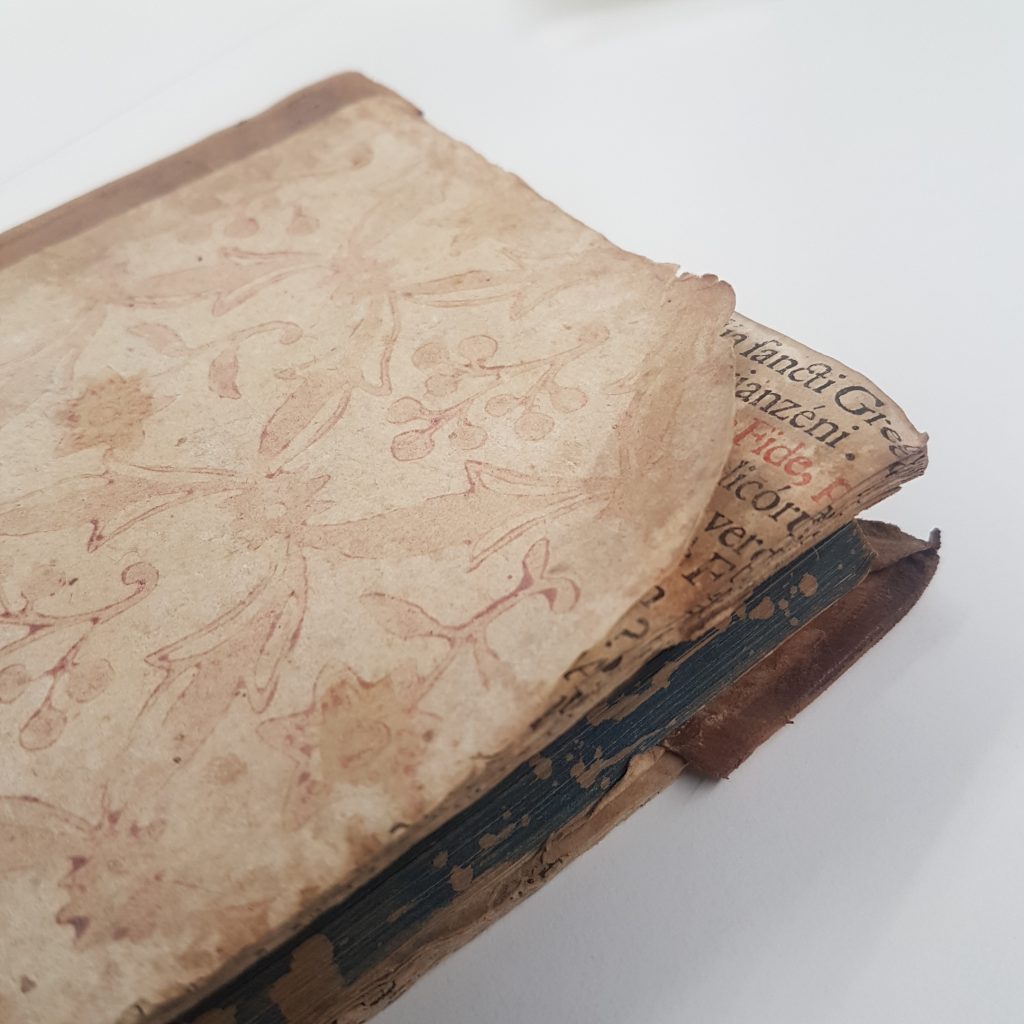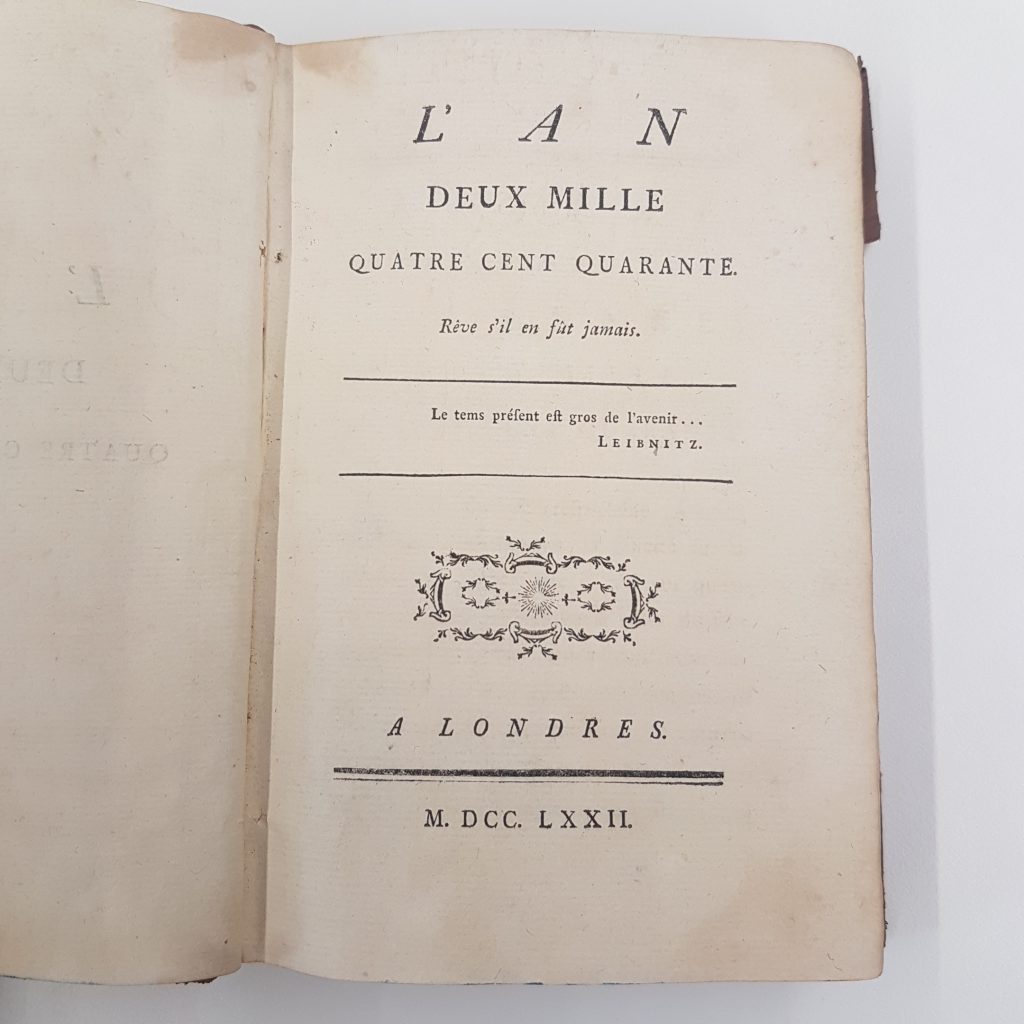State Library Victoria’s Rare Books Cataloguer Derrick Moors uncovered a fascinating item recently while working on the Wallace Kirsop Collection, a generous gift by one of this library’s greatest supporters. L’an deux mille quatre cent quarante. Rêve s’il en fût jamais (‘In the year two thousand four hundred and forty. Dream as if it were’) is a work of Utopian fiction by French author Louis Sébastien Mercier (1740-1814), first published in 1771. Not only is the text itself of great interest, but the book has a very special kind of binding: the ‘boards’ are made of fragments from an unidentified edition of paraphrases of the Psalms in Latin.

The word ‘utopia’, meaning ‘a perfect society’, was first used by Plato but is best known for its use by Sir Thomas More in his 1516 satire of the politics of his own day, Utopia. It derives from the ancient Greek for ‘no-place’ (ou-topos), but also plays on the homophonic Greek word ‘eu-topos’, meaning ‘good place’: on some level, we know it’s nearly impossible to create a perfect society. After More, utopian fiction became a popular genre, including many texts still read widely today, such as Jonathan Swift’s Gulliver’s Travels (1726).
In Mercier’s utopian story, set in Paris, the narrator wakes up 700 years after the time in which he lives to discover that the world has become an ideal society: privilege is abolished and merit is achieved through performing good works. Mercier’s hero notes everything that catches his fancy in futuristic Paris. Public space and the justice system have been reorganised; clothing is comfortable and practical; hospitals are effective; arbitrary arrest, slavery, taxes, foreign trade, coffee tea and tobacco are all unknown; there are no monks, priests, prostitutes, beggars, dancing masters (i.e. teachers), pastry chefs, standing armies or guilds; all useless and immoral previously-written literature has been destroyed. But Mercier’s future is not wholly positive. The extremes of wealth and poverty have been abolished, but nevertheless, the poor still exist. There is little economic development and France’s population has increased only by 50%.
Utopian fiction is almost always satirical in intent, and so it was that Mercier’s work was swiftly banned by France’s Ancien regime, which recognized that Mercier’s fantasy about ‘the future’ was a thin disguise for his real-life revolutionary sentiments. Despite this – or perhaps because of this notoriety – it became an international bestseller and was also published in many unauthorized, counterfeit editions.
This copy from the Wallace Kirsop Collection, from 1772, is one of the first of these counterfeit editions. The imprint is false; the true publisher was likely the Lausanne bookseller Francois Grasset. [1] One of the most striking aspects of the volume is its binding, which is made of woodblock-printed domino paper over boards that are themselves made of layers of paper. Since the dawn of European printing in the middle of the 1400s, the craftsmen and -women involved in making books had been keen recyclers, reusing the expensive materials involved whenever possible. The reuse of a religious book for its paper was especially common, as the information in these texts was regularly updated by the Church, rendering existing books out-of-date. The glue holding this book’s boards together has given way over the centuries, and a little peek of the paper waste within has become visible.

Ultimately, the Ancien regime that banned Mercier’s book would fall, during the French Revolution (1787-97). Given the secular and anti-clerical sentiment of the revolutionaries, the reuse of a liturgical book in the binding of this popular utopian, revolutionary story gains a new resonance, and reminds us of the many layers of history that we can find each time we take down a book from the shelf.

This post was written by Derrick Moors and Anna Welch
Notes
[1] Everett C. Wilkie, Jr, Mercier’s L’an 2440: Its publishing history during the author’s lifetime, Cambridge, MA, Harvard University Library, 1986, p. 44, 1772.3


A really interesting and well-written article covering different aspects of this book, and of this particular copy. Thanks Derrick and Anna, and of course, a big thank-you to Wal Kirsop.
Derrick and Anna. Thanks very much for the article. You are blessed being able to work with such old gems – and get paid for it !!!:)
Regards
CC
wonderful – let’s hope they can read it in 2440!
Thank you for your work. I love the stories of books as objects, as well as the history of the ideas within the books.